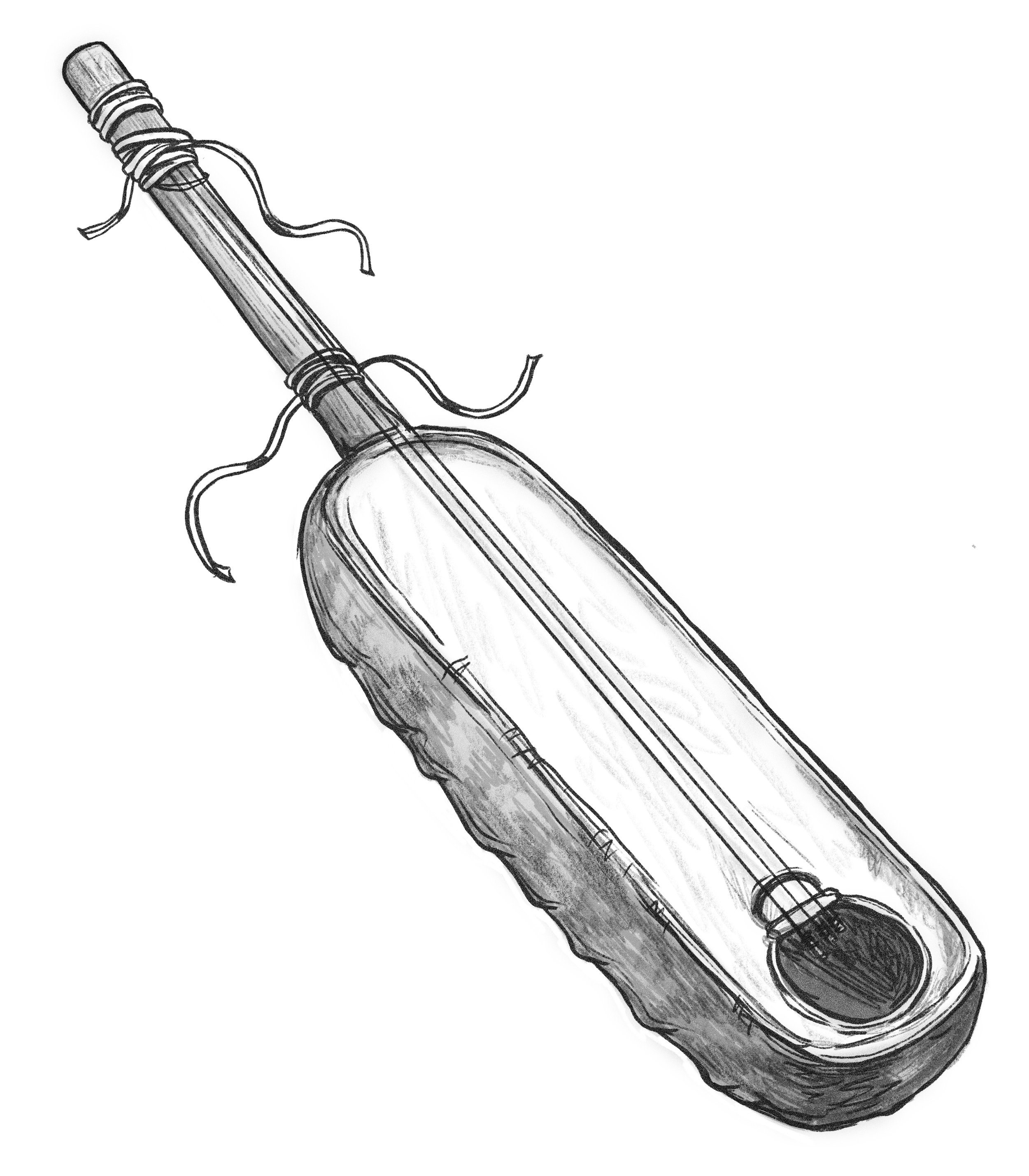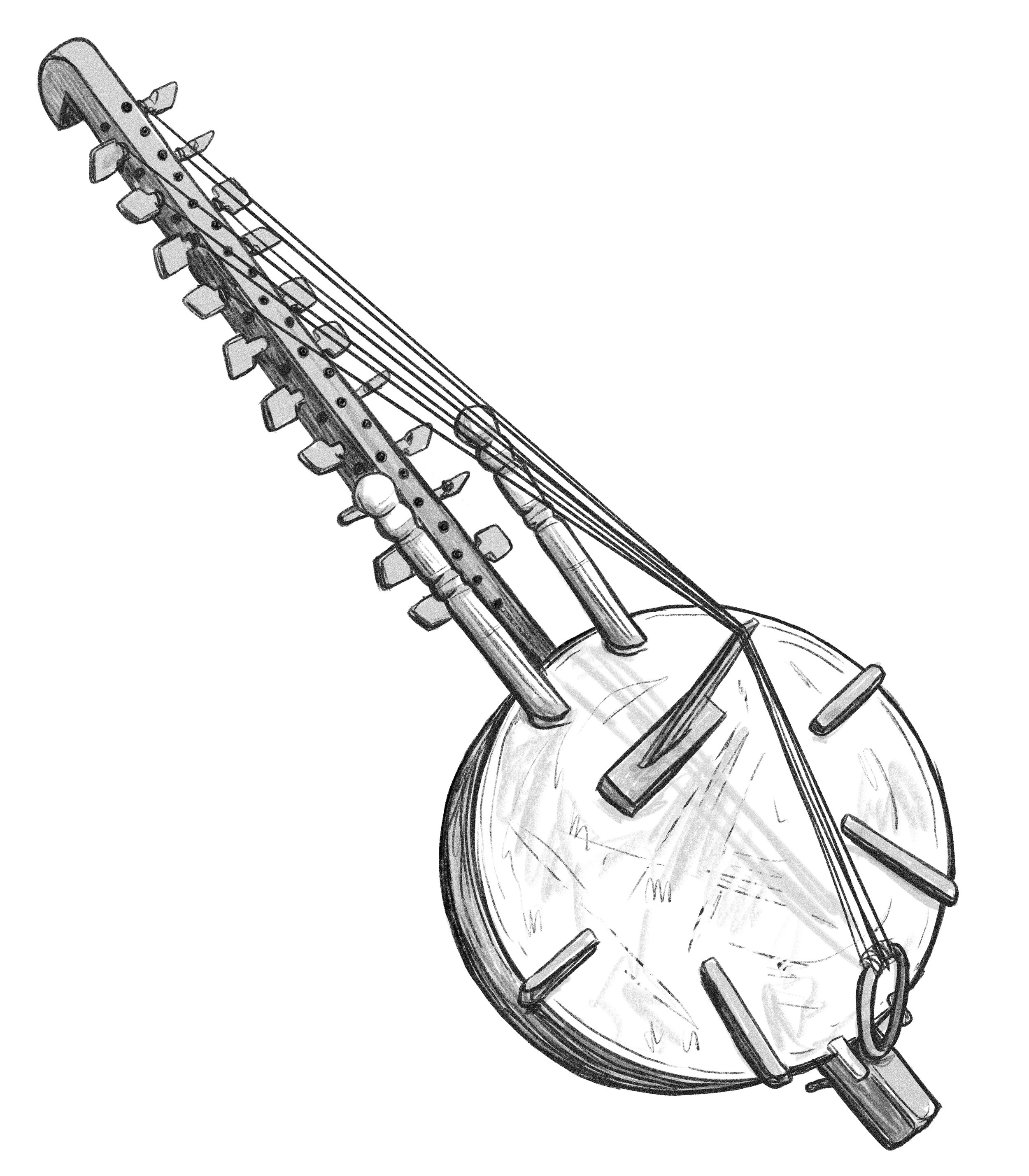Instruments of Africa
Since starting the Mother of Mankind radio show I have fallen in love with a number of instruments from Africa. It’s been a joy to learn about their history, their cultural context, how they have influenced more modern instruments, how their sounds have formed the basis for many contemporary styles of music. I found an incredible artist called Nadia Akingbule and I invited her to create seven illustrations of my favourite instruments. I hope you enjoy Nadia’s amazing art, and that you pick up some new insights into the instruments of Africa.
Jeli Ngoni
One of my favourite African instruments, which makes an incredible sound for such a modest looking instrument. It sounds a lot like a Banjo (or I should probably say that the Banjo sounds a lot like the Ngoni) and the roots of the Banjo are attributed to the Ngoni and its family of instruments.
It’s a small lute-like instrument from the Mandinka culture and was traditionally played in the Malian Empire. The Jeli Ngoni is a small version of the instrument which is played by Bassekou Kouyate - you can listen to Bassekou Kouyate on the Mali Show. The Donso Ngoni is much larger and has six strings and is also called a ‘hunters harp’ - Issa Bagayoga plays one of these on the same show.
Kora
In my opinion the king of the stringed instruments. It requires virtuosic levels of skill to play and can sound like multiple musicians playing at the same time because of the layers of sound. It is a Griot instrument, with Griots being the mediators and story-tellers within the community. This means that you would traditionally have to be born into a Griot family to be a Kora player, and would learn how to play from your father or uncle.
I was lucky enough to see one of the greatest living Kora players, Seckou Keita, perform live at St Georges in Bristol. I also interviewed him as a guest on my Senegal show where you can hear him talking about Griot culture, the significance of his Keita name, and making music in lockdown.
Kondi
A Sierra Leonean instrument made from a hollow wooden or metal body and metal ‘tongues’ that are plucked with the thumbs. The longest tongue makes the deepest sound and they are fine tuned by simply making the tongue slightly longer (more flat) or shorter (more sharp).
The Kondi name is from the Temne tribe but it is also referred to as also known as a Kututen (Limba tribe) and a Bundoma (Loko tribe). There is also a varation from Zimbabwe called the Mbira (Shona). Later, ethnomusicologist Tracy Hughs popularised the Kalimba (a Westernised version) to a global audience.
I discovered the instrument originally via the Kondi Band. They are made up of two key members - Chief Boima and Sori Kondi. Sori is a blind singer and Kondi player with an incredible voice and a naturally rhythmic sound. Chief Boima is a music producer who brings a modern electronic element to the music. I interviewed Chief Boima about their music and his Sierra Leonean heritage on my Sierra Leone show.
Balafon
This instrument can be traced back to the 12th century CE, with a separate lineage to the Marimba of Southern Africa and South America. It is found across West Africa from Guinea to Mali played by the Mandinka, Mande, Senoufo and Gur people. The instrument is made from a wooden frame and keys with resonant gourds underneath.
One of the masters of the instrument is Lassana Diabate of Mali. You can hear him playing the Balafon with the Afrocubism group on my Afro Cuba show and with Trio Da Kali on my Mali show.
Valiha
Generally regarded as the national instrument of Madagascar, the Valiha is a tube-shaped zither. It was traditionally made from a local type of bamboo call Valiha Diffusa and is typically between 5 to 10 cm in diameter and 35 to 180 cm in length.
I discovered the Valiha via an artist called Rajery. He is an incredible musician who was born with a disfigurement to one hand which makes his playing style and the sound of his music completely unique. He doesn’t have fingers on one hand which means that he has a much softer sound from playing with his hand. He is featured on an amazing album by Omar Sosa called An East African Journey which is featured on my Afro Cuba show where you can listen to an interview with Omar on that show where he talks to me about the making of that album.
Qaraqueb
Qaraqueb are metal castanets of the Gnawa tribes, typically made from iron and as a result are surpisingly heavy. Often played by a number of players from the Gnawa troup simultaneously using syncopated rhythms. I was given a set of these by my in-laws for Christmas so I’m planning to learn how to play this year!
They would have suited a nomadic lifestyle because they are very loud considering how portable they are, particularly compared to heavy wooden drums.
Check out my Morocco show to hear plenty of Qaraqueb action.
Guembri
A three-stringed bass instrument about the size of guitar which is also played by the Gnawa people. It has a camel skin across the front of a wooden body which does a similar job to the membrane on a banjo. Also known as a Sintir, it’s fretless and has a hypnotic sound due to its open tuning.
I was blessed to have the opportunity to interview the Guembri master Simo Lagnawi on my Morocco Show who plays in Gnawa London, as a solo artist, and with the group Electric Jalaba.







